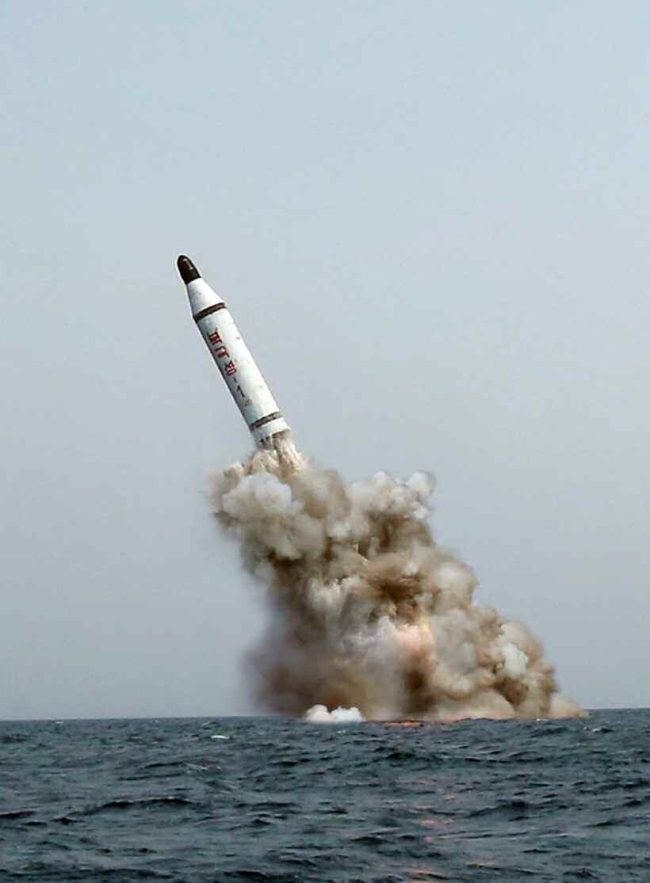North Korea’s push to develop a submarine-launched ballistic missile is posing a daunting security challenge to South Korea and the U.S. as the allies would have almost no means to counter the emerging threat should it become fully operational.
The allies have so far been focusing on countering missile threats from land-based launchers as they believed Pyongyang was far from developing an SLBM given the small size of its submarines and outdated technology.
But the North’s test-firing last week showed that the communist regime was close to completing the development of the strategic SLBM. Describing the test-firing as a success, the North called the launched projectile “a world-level strategic weapon.”
“There is no effective measure to counter the SLBM for now. It would be, per se, a final-stage, ultimate addition to the North’s strategic weapons list,” said Park Won-gon, security expert at Handong Global University.
 |
A ballistic missile, called Bukkeuksong, is shown being test-launched from underwater in a photo from a report by North Korea’s Rodong Sinmun on Saturday. (Yonhap) |
“Whatever top-of-the-line detection systems you have, it would be difficult to keep track of submarine movements. Obviously, there are limits when you conduct antisubmarine operations,” he added.
Seoul officials now forecast it would take four to five years for the North to fully develop and deploy the SLBM. They also think that the North will be able to build a 2,000-ton Sinpo-class submarine capable of carrying the SLBM in two to three years.
Analysts say that the North’s potential deployment of the nuclear SLBM would be a “game changer,” underscoring the need for Seoul to work on countering the new security challenge.
“Obviously, the question is whether North Korea has or will be able to mount a nuclear warhead on the SLBM. If so, this would represent a strategic game-changer,” said Michael Raska, research fellow at the Institute of Defense and Strategic Studies, affiliated with Nanyang Technological University in Singapore.
“Meanwhile, with gradually improving submarine capabilities, North Korea’s naval strategy may be shifting ― from a traditional coastal defense toward a more offensive type of operations,” he added.
Fears about the SLBM stem from the North’s potential “second-strike capability” to launch a surprise nuclear retaliation if it suffers a “first strike” from enemy forces.
The second-strike capability forms the basis of a condition referred to as “mutual assured destruction” that maintained the “balance of terror” between the U.S. and Soviet Union during the Cold War era. SLBMs are at the core of the capability as submarines can launch targeted surprise attacks on enemy forces.
Despite growing concerns over the North’s development of the SLBM, some observers remain doubtful of the North’s capabilities to develop an SLBM that can mount attacks on land-based targets.
“A true North Korean SLBM with land-attack capabilities would be a serious new threat. But so far I believe that we only have the North Korean statements and picture describing these missiles, and North Korea often seriously exaggerates its military capabilities,” said Bruce Bennett, senior defense analyst at the U.S. think tank RAND Corporation.
“Given the small size of North Korean submarines and the state of their missile technology, I suspect this missile will not have enough payload to carry a nuclear warhead, and may have only a few hundred kilometers’ range,” he added.
As the North appears to be developing the SLBM faster than expected, calls have been mounting for Seoul to devise a way to counter the SLBM threats, as there are no good ways to block SLBM attacks due to the difficulty in detecting deep-water submarines.
“Even if North Korea may take 5-10 years to pose a truly serious SLBM threat, it will also likely take 10 years or more for South Korea to acquire an adequate set of counters to SLBMs. So South Korea needs to be working on the counters now,” said Bennett.
To better handle the evolving nuclear and missile threats from the North, Seoul should step up security cooperation and intelligence sharing with Washington and Tokyo, some analysts said. Some also stress that Seoul should underscore the unacceptable cost Pyongyang would pay should it launch an SLBM to help ensure deterrence against it.
By Song Sang-ho (
sshluck@heraldcorp.com)








